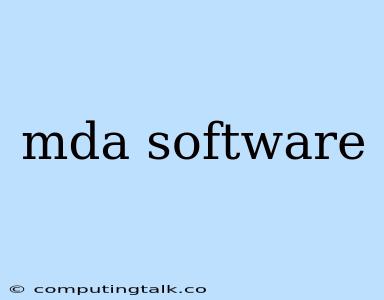What is MDA Software?
MDA software, or Model-Driven Architecture software, is a powerful approach to software development that emphasizes the use of models throughout the entire software lifecycle. This approach is becoming increasingly popular for several reasons. First, it allows developers to create software that is more robust, maintainable, and adaptable. Second, MDA software can help organizations to improve their software development processes and reduce the time and cost of software development.
Key Features of MDA Software
MDA software is characterized by a number of key features, including:
- Model-centric approach: MDA software focuses on creating and using models to represent different aspects of software systems, including the business domain, software architecture, and implementation details.
- Abstraction: MDA software allows developers to work at a higher level of abstraction, focusing on the business logic and requirements rather than the underlying technical details.
- Code generation: MDA software can automatically generate code from models, reducing the amount of manual coding required and improving the consistency of the software.
- Platform independence: MDA software can help to create software that is platform-independent, making it easier to deploy and maintain the software on different platforms.
- Flexibility and adaptability: MDA software allows for easy adaptation to changes in requirements or technology, ensuring that the software can evolve over time.
Benefits of Using MDA Software
Using MDA software offers a number of benefits for software development organizations, including:
- Improved software quality: By focusing on models and code generation, MDA software helps to reduce errors and improve the overall quality of the software.
- Reduced development time and cost: Automatic code generation and the ability to reuse models can significantly reduce the time and cost required to develop software.
- Increased maintainability and scalability: The use of models and abstraction makes it easier to understand and maintain the software, allowing it to scale more effectively to meet changing business needs.
- Improved communication and collaboration: Models can serve as a common language for communication between different stakeholders, such as business analysts, developers, and testers, improving collaboration and understanding.
- Increased agility and responsiveness: MDA software enables faster and more flexible responses to changing business requirements, improving the overall agility of software development teams.
How MDA Software Works
MDA software typically involves the following steps:
- Model the business domain: This step involves defining the business processes and requirements of the software system.
- Model the software architecture: This step defines the overall structure and organization of the software system, including the various components and their relationships.
- Model the implementation details: This step defines the specific details of the software implementation, including data structures, algorithms, and user interfaces.
- Generate code from models: MDA software uses code generation tools to automatically generate code from the models created in previous steps.
- Deploy and maintain the software: The generated code is then deployed and maintained, with the models providing a central source of truth for the software system.
Different Types of MDA Software
There are several different types of MDA software, including:
- Platform-specific MDA software: This type of software is designed for specific platforms or technologies, such as Java or .NET.
- Platform-independent MDA software: This type of software is designed to be platform-independent, allowing developers to create software that can be deployed on different platforms.
- Domain-specific MDA software: This type of software is designed for specific domains, such as financial services or healthcare.
Choosing the Right MDA Software
Choosing the right MDA software for your needs depends on a number of factors, including:
- The specific needs of your project: Consider the size and complexity of your project, the specific technologies involved, and the level of automation required.
- The experience of your development team: Make sure your team has the necessary skills and experience to work with MDA software.
- The cost of the software: MDA software can range in price from free and open-source to expensive commercial solutions.
- The support and documentation provided by the vendor: Ensure that the vendor provides adequate support and documentation to help you get started and use the software effectively.
Conclusion
MDA software offers a powerful and effective approach to software development that can help organizations to improve the quality, timeliness, and cost-effectiveness of their software development processes. By embracing a model-driven approach, organizations can achieve greater flexibility, adaptability, and maintainability in their software systems, leading to improved business outcomes.
As the adoption of MDA software continues to grow, it is expected to play an increasingly important role in shaping the future of software development. Whether you are a seasoned software developer or just starting your journey into the world of software development, understanding MDA software can be a valuable asset in your toolbox.
